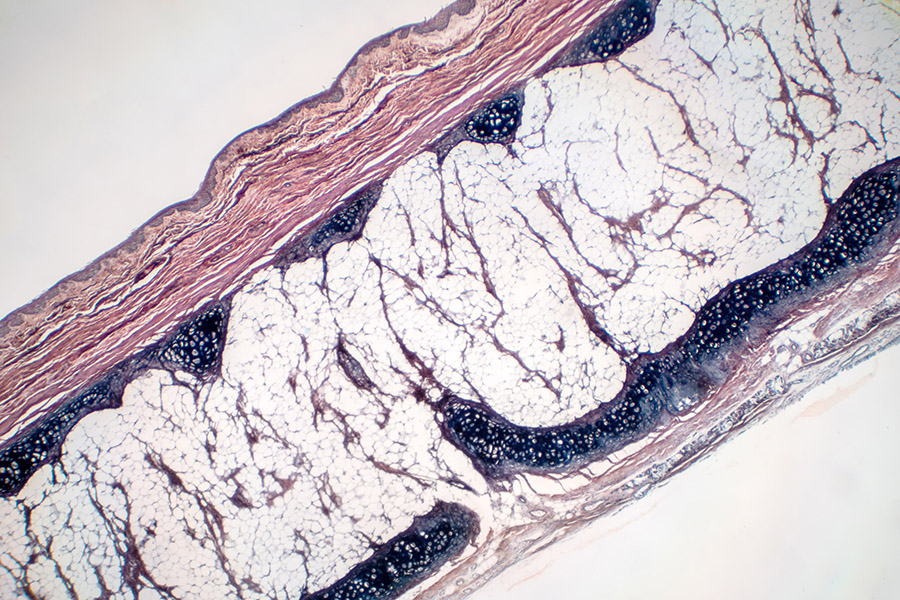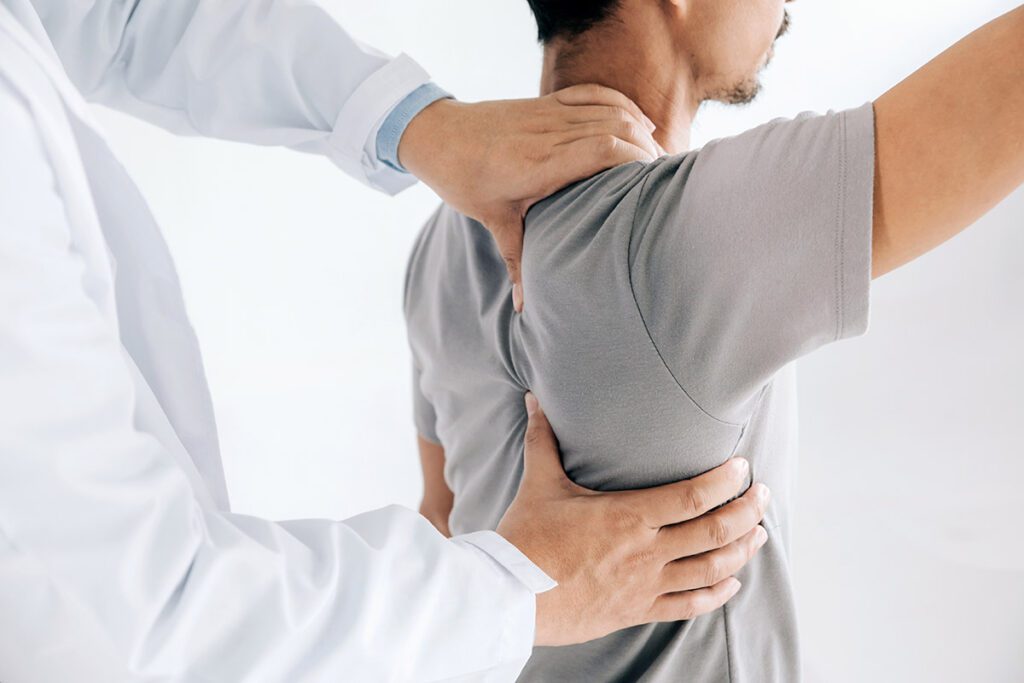

Rotator Cuff Tears
A rotator cuff is a group of tendons and muscles holding the “ball” of your upper arm bone (humerus) to the shoulder joint socket. The rotator cuff stabilizes and moves your arm up and away from your body. However, when a tendon is torn, it can cause pain and other problems.
What is a Rotator Cuff Tear?
Rotator cuff tears occur when one of the tendons of the rotator cuff partially or wholly tears from the bone, it causes difficulty in using the arm or moving the shoulder due to pain and weakness.
Risk Factors and Causes of Rotator Cuff Tear
Risk factors for rotator cuff tears include smoking, maintaining poor posture, and a familial history of said injury. Rotator cuff tears happen from injury or from wearing down.
Rotator Cuff Tear from Injury
An acute rotator cuff tear from an injury can occur when the tendon tears from the bone due to a fractured collarbone or a dislocated shoulder.
Rotator Cuff Tear from Wearing Down
Chronic rotator cuff tears can occur from overuse injuries or age.
People with professions or hobbies that require repeated overhead motions or repeated cocking and throwing of the arm can result in overuse injuries. Construction workers, mechanics, and painters must move their arms overhead to do their work. Sports like weightlifting, rowing, baseball, and tennis demand constant power, strength, and endurance for the rotator cuff.
When people age, they have an increased chance of their rotator cuff wearing down. Bone spurs can stress the tendons every time the arm moves. Blood flow can decrease from the rotator cuff area from chronic conditions.
Signs and Symptoms of Rotator Cuff Tear
Here are the most common symptoms of rotator cuff tears. Some people will experience only some of them or may experience them differently.
For acute rotator cuff tears:
- Intense pain in the shoulder
- Snapping sensation
- Immediate weakness
For chronic rotator cuff tears
- Dull ache or stabbing pain in the deep part of the shoulder
- Pain that reoccurs, especially with specific movements or activities
- Difficulty moving the arm in specific movements due to pain and weakness, such as raising, lowering, or rotating the arm (like combing the hair or clasping on a bra from behind)
- Difficulty lifting things due to pain and weakness
- Crepitus or grating, cracking sounds when doing arm movements
- Pain that discourages you from sleeping on your affected side
How Serious is a Torn Rotator Cuff: Can It Heal on Its Own?
If a torn rotator cuff does not get any treatment, the injury will worsen. It will lead to long-term pain in the shoulder until over-the-counter medication may no longer relieve it. It can also make daily activities difficult as the shoulder progressively weakens.
When to See a Health Care Provider
Please seek medical care if the following symptoms occur:
- Immediate weakness (a complete tear can make it impossible to move the arm)
- Injury on the shoulder
- Sudden and severe shoulder pain
- Persistent or worsening shoulder pain
- Pain with dizziness and difficulty breathing
- Pain that disrupts sleep
- Difficulty doing daily activities
- Swelling, redness, warmth, and bruising on shoulder joint
Rotator Cuff Tests You Can Do At Home
These self-assessment tests can let you know if your rotator cuff is injured. Detecting the injury can lead to early intervention before the condition gets worse. Take note that your doctor may do the same tests during physical examination.
Empty-Can Test
This physical therapy test checks if the tendon of the supraspinatus muscle is injured. The supraspinatus muscle is the topmost muscle of the rotator cuff.
- Sit or stand comfortably.
- Hold out your arm that you want to test to the side as if you’re holding a can.
- Move your arm forward by 30-45 degrees.
- Turn your hand as if to empty the can.
- Have a person put pressure on your arm as you try to maintain its position.
The supraspinatus tendon may be injured if there is pain or weakness in maintaining the position.
Resistance Testing
The rotator cuff working together can hold the position of your arm as it keeps the “ball” of your humerus to your socket. Testing its strength can tell us the condition of your shoulder.
- Sit straight on a chair.
- Flex your elbow to 90 degrees with the elbow close to your side.
- Hold the position of your elbow as someone pushes your hand into your belly.
If there is pain or weakness in maintaining the position, there may be a rotator cuff tear.
Diagnostic Tests & Treatment
Diagnostic tests are essential to confirm the actual diagnosis of a person’s condition. Since rotator cuff tears share similar symptoms as other rotator cuff conditions, going to a doctor can help establish the nature of the injury.
After obtaining the person’s medical history and physical exam, the healthcare provider may recommend the following diagnostic tests:
- X-Ray: This imaging test can confirm the presence of arthritis or bone spurs on the shoulder joint.
- MRI: Magnetic resonance imaging can give detailed images of the shoulder, including the presence of the tear and its size, location, and whether the tear is old or new.
- Ultrasound: US can assess the shoulder muscles and tendons during movement.
Treatment
Treatment for rotator cuff tears can either be conservative or surgical, depending on the injury’s severity.
A conservative treatment is applied for mild to moderate cases.
- Arm Sling and Rest: The injured arm must be immobilized to prevent further aggravation.
- NSAIDs: Non-steroidal Anti-inflammatory Drugs lessen pain and swelling.
- Physical Therapy: Physical therapy involves exercises and other treatments to minimize pain and swelling. Strengthening exercises maintain and improve strength. At the same time, stretching exercises ensure the shoulder’s range of motion. Pain treatment like ultrasound therapy promotes healing by increasing blood flow to the shoulder area.
- Corticosteroid Injection: This injection relieves pain that disrupts a person from sleeping, daily activities, and physical therapy rehabilitation.
Surgery is for severe cases where conservative treatment may not be helpful. Acute tears may call for surgery. If a person has persistent symptoms for a year, has a large tear of more than 3 cm, or has such a significant loss of strength and function in the arm, they may benefit more from surgical intervention.
The surgery aims to reattach the torn tendon back to the bone. Or trim frayed pieces of a partial tear. Here are some of the shoulder surgeries a doctor may prescribe for a person’s condition:
- ArthroscopicTendon: One of the most minimally invasive procedures, a tiny camera is inserted along with other surgical tools through small incisions to reattach the tendon.
- Open Tendon Repair: Tendon reattachment through a larger incision can be best for some cases.
- Tendon Transfer: If the torn tendon is too damaged, a nearby tendon is used as a replacement.
- Reverse Shoulder Replacement: To re-stabilize the shoulder joint, the shoulder’s ball-and-socket joint is replaced with an artificial ball connected to the shoulder blade and the artificial socket attached to the humerus.


Prognosis: How Long Does a Rotator Cuff Tear Take to Heal?
The prognosis depends on the age and health of people with rotator cuff tears. Most cases see improvements after conservative treatment. Mild tears will heal within a month.
Most people who underwent surgical treatments recover their strength, function, and range of motion with physical rehabilitation. Recovery from surgery may take up to nine months to completely heal.
Prevention
It is possible to re-tear the injury, especially if the tear is more extensive than an inch. Re-tearing the rotator cuff can require surgery due to intense pain and lack of movement. To prevent this, here are measures to take:
The general idea is to maintain the flexibility of the muscles and tendons. While the rotator cuff must be strong enough to hold the humerus to the shoulder joint, it must be matched with flexibility to allow range of motion and prevent tearing.
- Do warm-up stretches before exercising or working.
- Do cool-down stretches before exercising or working.
- Learn how to lift appropriately by using the legs with a straight back to avoid over-exerting the arms.
- Do shoulder strengthening exercises of the upper arm and scapular to stabilize the
Rotator cuff tears are an injury that can change how a person works and does their daily activities. If you suspect you have this injury, it is best to see a doctor for early intervention. Schedule an appointment today for optimal care with us.
Shoulder Doctors
- Foot and Ankle Orthopedic Surgery
- Knee Orthopedic Surgery
- Shoulder Orthopedic Surgery
- Sports Medicine
- Knee/Foot/Ankle
- Orthopedic Sports Medicine
- Orthopedic Surgery
- Complex Knee
- Shoulder
- Sports Medicine



























